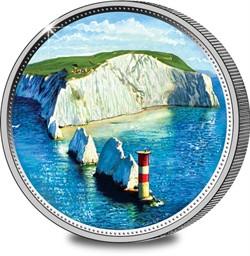-no-button.jpg)
 |
Location: Northwest coast of the Isle of Wight,
Southern England
Date completed: formed during Alpine orogeny 66 million years
ago
Designers/builders: Natural feature
Function: Tourist attraction, lighthouse base
|
The first impression of the Needles on the North West tip of the
Isle of Wight is that, while spectacular, they don't look
particularly needle-like, resembling more jagged teeth. The name
has its origins in a fourth column, called Lot's Wife, which was
needle shaped and gave the name to the whole
formation. Unfortunately, Lot's Wife collapsed during a fierce
storm in 1764, but the rocks retained the name. Three rocks, rising
to about 100 ft (30 m), form the Needles, which are part of a chalk
ridge that forms the backbone of the Isle of Wight. The Needles is
a popular tourist attraction for holidaymakers on the Isle of
Wight, its popularity helped by their proximity to Alum Bay and the
Needle Pleasure Park situated at the top of the cliff. There are
breathtaking views, historic sites and the Needles Park Chairlift
from the cliff-top down to Alum Beach, providing a bird's eye view
of the beach and the multi-coloured cliffs. The military were
also attracted to the site over the years. An artillery battery was
installed in the 1860s and later decommissioned. The headland
at High Down was used for testing of the Black Knight and Black
Arrow rockets from 1956 to 1971. Both the Battery and Rocket
Testing rooms are popular visitor attractions. The Needles are
undoubtedly a fascinating sight, but for years these rocks were a
dangerous hazard for shipping making their way up the Solent to
Southampton and Portsmouth. In 1786 Trinity House built a new
lighthouse on the cliff-top overlooking Scratchell's Bay but at 427
ft (144 m) it was often hidden by sea mist. In 1859 Trinity House
built a new lighthouse. Built of granite on the outermost of the
Needles rocks, it was 109 ft (33. 25 m) high. This is essentially
the Lighthouse which forms such an iconic part of the Needles
seascape. The builders cut away much of the base rock to form
foundations and underground store rooms. In 1987 Trinity house
constructed a helipad and on 8th December 1994 the keepers left the
lighthouse for the last time when it was automated.